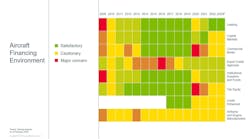One of the most exciting parts of my job is gaining early insight into the technological innovations manufacturers are developing to bring greater safety and other enhancements to general aviation aircraft. I don’t have the room available to mention all of them in this column, but want to highlight a few that are especially noteworthy.
Safety Enhancements
Losing engine power in an aircraft can be one of the scariest situations a pilot can face, and it’s often a contributing factor in fatal accidents. But BRS Aerospace parachutes on GA aircraft have saved more than 300 lives so far, and the Cirrus Airframe Parachute System, or CAPS, has saved more than 105 lives when this system has been correctly deployed during an engine malfunction. One of those saves came earlier this year, when a pilot flying from California to Hawaii radioed for help because his airplane was running low on fuel. He pulled the parachute and the plane descended at a controlled rate to the ocean, where he was rescued by the Coast Guard.
More recently, Cirrus partnered with Garmin to develop the Electronic Stability & Protection (ESP), which recognizes when a pilot is overbanking the airplane — and then allows the autopilot system to gently push back to warn the pilot that he or she is potentially overbanking. The pilot can also override the system if needed. ESP is another critical development for improving pilot safety.
Cockpit Improvements
After careful analysis of GA accident data, GAMA members started pursuing loss-of-control risk mitigation technology for the existing fleet. Angle-of-attack (AOA) indicators — which for years have been used in military, commercial, and business aviation — can help inform pilots of their wings’ ability to generate lift and thereby avoid stalls. Last year, the FAA released a policy that permits a streamlined path to get AOA onto general aviation aircraft. Today, several GAMA members — including Aspen Avionics, BendixKing, Garmin, and Safe Flight Instrument Corporation — have AOA equipment for sale. Installation and use of AOA is an integral part of the FAA’s Fly Safe national safety campaign launched this summer to prevent loss-of-control accidents.
Fly-by-wire systems have been commonplace in military aircraft for decades and have only been introduced to business aviation over the last few years. However, today we are seeing this technology migrate to small airplanes, which opens up an entire new world of innovation in design and flight control. Fly-by-wire is also being introduced in rotorcraft, making the complex tasks of flying and maintaining these machines all the better.
Another cockpit improvement is the introduction of the enhanced vision system. It fuses an infrared camera system with detailed terrain databases and GPS navigation to allow a pilot to see his or her surroundings in darkness or poor weather. When coupled with a heads-up display, situational awareness is greatly enhanced by giving pilots a much crisper, all-weather, day-or-night picture.
The glass cockpit is hastening the end of steam gauges in cockpit displays and rendering flight and navigation data much more clearly and in a more user-friendly way than ever before. Many glass cockpits can be easily retrofitted into a pilot’s existing panel and offer vast amounts of information technology at a touch of a button or the screen—thus enhancing safety.
All of these innovations are not only making general aviation safer, but spurring engineers, maintenance professionals, pilots, and manufacturers to speed development cycles and offer new and exciting capabilities that in some cases are primarily facilitated by software enhancements. As a pilot and as the leader of GAMA, I’m excited to postulate what new technological capability will come next.

